-
Posts
1,968 -
Joined
-
Last visited
Content Type
Profiles
Forums
Developer Articles
KSP2 Release Notes
Bug Reports
Posts posted by LaydeeDem
-
-
Got my hands on a Canon 50mm f/1.8 STM lens in July. Lets in lots of light and is pretty sharp when stopped down to f/3. Have been a very busy bee since!
 Spoiler
SpoilerTwo of our largest galactic neighbors, the Andromeda Galaxy (M31) and the Triangulum Galaxy (M33) framed up nicely inside the FoV provided by the Canon 50mm f/1.8. Very near to Mirach the galaxy NGC 404 can also be seen.
Gear Used:
Camera - Canon EOS 350D
Lens - Canon 50mm f/1.8 STM
Mount - Nyxtech NyxTracker V2Acquisition:
Aperture - f/2.5
ISO-1600
37x30" sub exposures
~18min total integration timeSoftware Used:
Adobe Photoshop
Deep Sky Stacker
Pixinsight 1.8 Spoiler
SpoilerA dusty region of the Milky Way at the intersection of Serpens Cauda and Aquila. Part of the Great Rift, a dark band of dust that stretches from Cygnus to Centaurus. Wild Duck Cluster is visible in the lower left
Gear Used:
- Camera - Canon EOS 350D unmodded
- Lens - Canon 50mm f/1.8
- Mount - NyxTech NyxTracker
Acquisition Info:
- 19x30" lights
- 9.5 minutes total integration
- no darks, flats, bias
- f/3.2
- ISO-1600
Software Used:
- Adobe Camera Raw
- Deep Sky Stacker
- PixInsight 1.8
- Adobe Photoshop CS5.1
 Spoiler
SpoilerA fleeting glimpse into the Southern Sky. Corona Australis (Bottom left) is a faint constellation just beneath Sagittarius and is home to the Corona Australis Molecular Cloud, a star-forming region 430 light-years away from our Solar System, adjacent to the nebulosity is the globular cluster NGC 6723, though close in the sky, NGC 6723 is actually ~28,000 light years further away. Imaging was quite a challenge as Corona Australis was only 14 degrees above the horizon at the time of imaging and the afternoon's storms were still clearing out. Thankfully enough subs were cloud-free to provide a decent SNR.
Acquisition Details:
- Captured just before moonrise, 8/21/19
- 15x30" lights
- 7.5 mins total integration
- f/3.2
- ISO-1600
- Bortle Class 4 skies
Gear:
- Camera - EOS 350D
- Lens - Canon 50mm f/1.8
- Mount - NyxTech NyxTracker V2
- Tripod
Software Used:
- Adobe Camera Raw
- Deep Sky Stacker
- PixInsight 1.8
- Adobe Photoshop CS5.1
Notes:
-Image is displayed at 75% final resolution
-Image is processed for natural colorCygnus: From Cepheus to Vulpecula
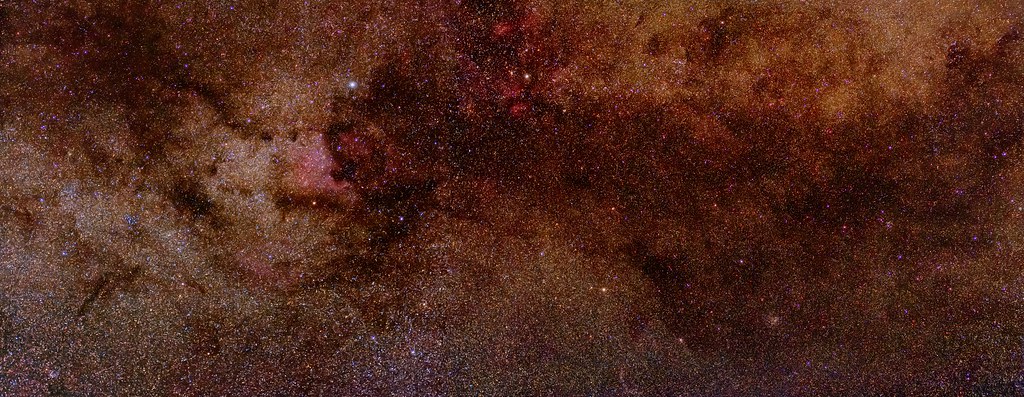 Spoiler
Spoiler2 pane mosaic of the constellation Cygnus and some of the constellation Vulpecula using my previous 2 images of the region. Cygnus is home to an incredibly active star-forming region and a large population of hot, young blue stars known as the Cygnus OB2 association, though most of it is obscured by a patch of interstellar dust known as the Cygnus Rift.
Image details:
- 2 pane mosaic captured over 2 nights.
Left Panel:
- 14x30" subs
- 7 minutes total integration
- ISO-1600
- f/3.2
Right Panel:
- 26x30" lights
- 13 minutes total integration
- f/3.2
- ISO-1600
Gear Used:
- Canon 350D unmodded
- Canon 50mm f/1.8 STM
- NyxTech NyxTracker V2
Software Used:
- Adobe Camera Raw
- Adobe Photoshop CS5.1
- PixInsight 1.8
- Deep Sky Stacker
Notes:
- Processed to the best of my ability for natural color
Dark Nebulae in Cygnus & Cepheus:
 Spoiler
SpoilerWide image of dark patches of interstellar dust on the border of the constellations of Cepheus and Cygnus, the two largest dark nebulae that dominante the frame and are visible to the naked eye under dark skies are Le Gentil 3 ( left) and the Northern Coalsack (right). Residing among the dust clouds are vast star forming hydrogen emission nebulae, including the Elephant's Trunk (left) and the famous North America Nebula (right). To the bottom right is Herschel's Garnet Star, aka Mu Cephei, a dying red supergiant star poised to go supernova within next few centuries.
Acquisition Details:
Captured late August 28, 2019
12x30" sub exposures
6 minutes total integration
ISO - 1600
f/3.2
Daylight White BalanceGear Used:
Camera - EOS 350D
Lens - Canon 50mm f/1.8 STM
Mount - NyxTech NyxTracker V2Software:
Adobe Camera Raw
Sequator
PixInsight 1.8
Adobe Photoshop CS5.1Notes:
-Image has been mosaicked with my previous Cygnus image to provide better framing.
- My first attempt stacking using Sequator. I like how fast it is! However I don't think it has drizzle capability and I think images come out of it noisier than using Deep Sky Stacker, thought this could be error on my part.Any my crowning achievement for the Summer, an image worth printing;
 Spoiler
SpoilerThe Milky Way is setting 4 minutes earlier, every day. This late into August, the window of time to see the Milky Way this year is rapidly closing. While I plan to image it as much as possible before the Autumn and Winter skies bring their treasures, I thought it would be appropriate to give the Summer views of our home galaxy a send-off of sorts in the form of a jaw-dropping image. This is my first attempt at doing an advanced mosaic with a foreground landscape, unfortunately where the Milky Way sets is swamped with light pollution from Albuquerque but I tried to subtract as much as possible while still trying to be true to the scene.
Acquisition Details:
Image is a 3-pane mosaic covering roughly ~35 degrees of sky on the vertical axis. A still image of the ground has been blended in with the tracked mosaic
Captured on August 21, 2019 from my backyard near Santa Fe, NMTop Panel:
2x30"Middle Panel
2x30"Bottom Panel
2x30" tracked
1x30" untracked for the ground3 minutes 30 seconds total integration for the whole mosaic
ISO-1600
f/3.2
Bortle Class 4 skiesGear:
Camera - EOS350D unmodded
Lens - Canon 50mm f/1.8 STM
Mount - NyxTech NyxTracker
TripodSoftware Used:
Adobe Camera Raw
Adobe Photoshop CS5.1
PixInsight 1.8Excited for the Winter Skies now. Clear skies all!

-
Whew it's been a while! I promise I'm not dead. Just been really busy. Not a lot of time to play KSP let alone get out and shoot

That said I have been enjoying the return of the summer skies. Even ordered a new lens for Milky Way season, it hasn't arrived yet though.
The Great Rift:
The Great Rift is an area of dark bands stretching from the constellation Cygnus to the constellation Centaurus. They are thought to be clouds of interstellar dust in our galaxy's spiral arms.
Two satellites can be seen crossing the sky in this mosaic. The first (bottom left) is likely USA 182 aka Lacrosse 5, a radar reconnaissance satellite and the second (center) is likely a spent stage from the Soviet Zenit-2 rocket that launched Cosmos 1697, a Tselina-2 radio surveillance satellite.
Info and Fullres:
SpoilerGear Used:
Canon 350D
Canon EFS 18-55mm
NyxTech NyxTrackerAcquisition Info:
6 panel mosaic
1x60" sub exposures per panel
6 min total integration time
ISO 1600
f/3.5
18mm focal lengthSoftware Used:
Adobe Photoshop CS5.1
PixInsightNotes:
-A sliver of the bottom-right corner is cloned data.May 14 Daytime Moon:
Daytime view of the waxing gibbous moon from 5-14. Visible towards the lunar terminator is the Moon's "golden handle", caused by mountain peaks on the western end of Sinus Irdium being illuminated by sunlight. Stack of ~14 individual frames. Stacked using AutoStakkert! 2 with 1.5x drizzle and sharpened using RegiStax. Taken with a Canon 350D with a 75-300mm lens at f/11. Proof you don't need a lot of aperture to squeeze some detail out of the Moon!
And best for last, a nice zoomed in view of the Milky Way Core from a few nights ago. My first attempt doing RAW conversion for astrophoto work in RawTherapee! I love the control it gives me.
Milky Way Core Widefield:
Annotated Version:
Image Info:
SpoilerThe central region of the Milky Way at the intersection of Sagittarius, Ophinicus and Scorpius.
Gear Used:
-Camera: Canon EOS 350D (APS-C)
-Lens: Canon EF-S 18-55mm
-Mount: Nyxtech NyxTrackerAquistion Details:
15x42" sub exposures
10.5 min total integration
ISO-1600
f/4.5
35mm focal lengthSoftware Used:
RawTherapee
DeepSkyStacker
Pixinsight 1.6
rnc-colorstretch
Adobe Photoshop CS5.1
-HLVG Plugin -
Summer skies are finally coming back! \o/
Stayed up til dawn to get the Milky Way about 2 weeks ago.
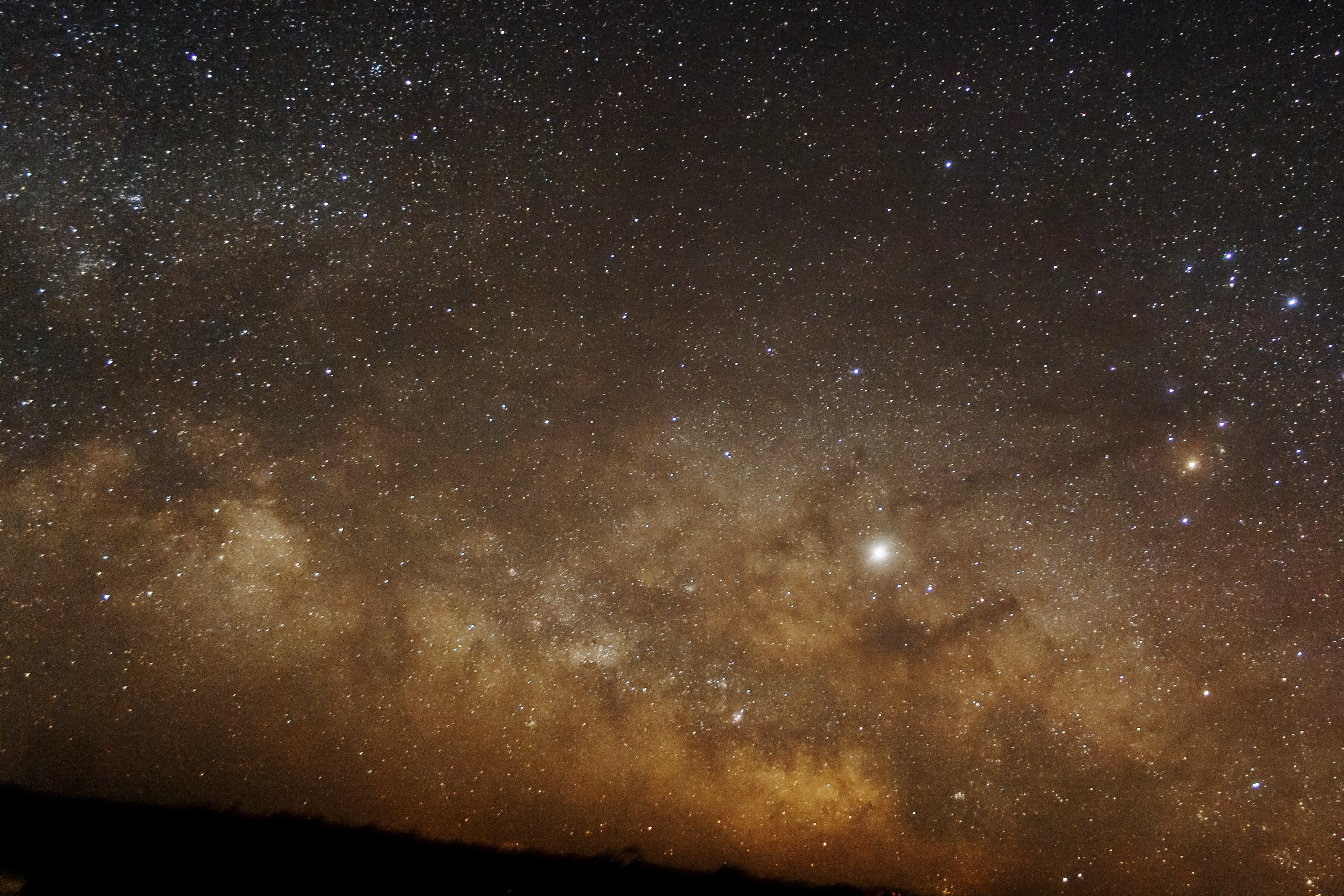
I forgot how dang bright the MW is. You do NOT need a lot of integration time to get a good image of it! The above is a stack of 2x60" exposures.
Image Details
SpoilerGear Used:
Canon 350D
Canon EFS 18-55mm
NyxTech NyxTrackerAcquisition Info:
2x60" sub exposures
ISO 1600
f/3.5
18mm focal lengthSoftware Used:
Adobe Photoshop CS5.1
-DeepSkyColors HLVG plugin
PixInsight -
Spoiled myself for my 21st birthday and bought a star tracker. My photos have improved immensely! Only problem is my wide lens has really bad coma. I have to do some heavy cropping to make these look good. I'm hoping purchasing a fast prime lens in the future will fix some of this. Also been playing with the PixInsight trial and holy crap it's powerful! The color calibration and ACDNR tools have allowed me to accomplish a lot more than Photoshop ever allowed. I'll definitely need to buy it when I have the cash!
Orion & Friends:
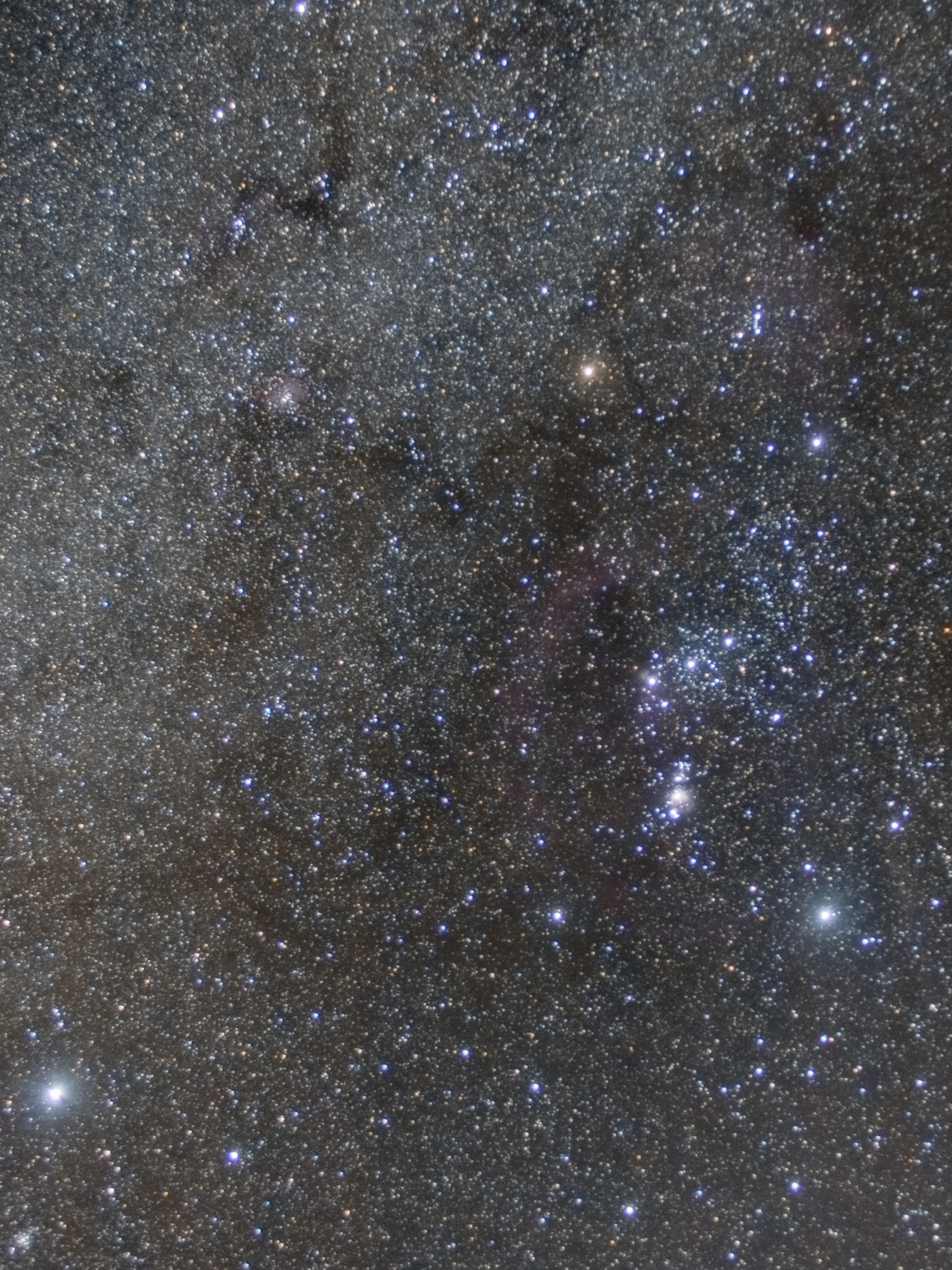
Image details:
SpoilerWide angle view of the constellation Orion. Many deep sky objects can be seen in this wide view. Including The Great Nebula (M42) in Orion's sword, the Horsehead (Barnard 33) and the Flame Nebula (NGC 2024) in Orion's Belt, to the left of Betelguese is the Rosette Nebula (Caldwell 49) in Monoceros, and faint traces of the Witch's Head Nebula (IC 2118) and Barnard's loop can also be seen along with a plethora of dark nebulae.
Gear Used:
Camera - Canon EOS 350D
Lens -Canon EFS 18-55mm
Mount - NyxTech NyxTrackerAcquisition Details:
69x60" sub exposures
1h9m total integration time
18mm focal length
f/3.5
ISO-1600Software Used:
Adobe Camera Raw
Deep Sky Stacker
PixInsight 1.8
Adobe Photoshop CS5.1Processing details:
Lens-corrected and converted to lossless TIF in Adobe Camera Raw.
Converted TIFs were stacked in Deep Sky Stacker using Kappa-Sigma Clipping. Stacked image was sent to PixInsight for Background Extraction, ACDNR noise reduction, background neutralization, color calibration and a non-linear histogram stretch. Green cast removed from stretched image using SCNR and a star reduction was done using a Star Mask and MorphologicalTransformation. Final image was saved as lossless TIF and cropped in Adobe Photoshop.The Jewels of Taurus:

Image details:
SpoilerWide angle view of the constellations Taurus and Perseus. Several deep sky objects can be seen in this image, including the Hyades cluster, the Pleiades and the California Nebula. Also visible are the dark dust lanes of the Milky Way.
Gear Used:
Camera - Canon EOS 350D
Lens - Canon EFS 18-55mm
Mount - NyxTech NyxTracker 2.0Acquisition Details:
68x60" sub exposures
68 minutes total integration time
18mm focal length
f/3.5
ISO-1800Software Used:
Adobe Camera Raw
Deep Sky Stacker
PixInsight 1.8Processing details:
Lens-corrected and converted to lossless TIF in Adobe Camera Raw.
Converted TIFs were stacked in Deep Sky Stacker using Kappa-Sigma Clipping. Stacked image was sent to PixInsight for Background Extraction, ACDNR noise reduction, background neutralization, color calibration and a non-linear histogram stretch. Green cast removed from stretched image using SCNR. Cropped using DynamicCrop and saved as lossless .png.Also got up early to capture Venus and Jupiter in conjunction on 1/16. Lots of ice particles in the air. Caused oval coronae around both and it started snowing!



That's it for now. Clear skies everyone.

-
Looks like the lobes are less spherical than we thought.
-
11 hours ago, lajoswinkler said:
@LaydeeDem I used Charon's north pole's color from the natural color image (blurred it massively and picked the color) to colorize Ultima Thule, and then brought the contrasts and lightness down to appear similar to those few Juno's Ceres photos that are not overexposed. Granted, Ceres has lower albedo but it's closer to the Sun so yeah, take this with a grain of salt. I think it matches my idea of chernozem pretty good. Consider this could be something like seeing it with naked eye in a spacecraft, in those light conditions. For best effect, open in something without white background to blind you.
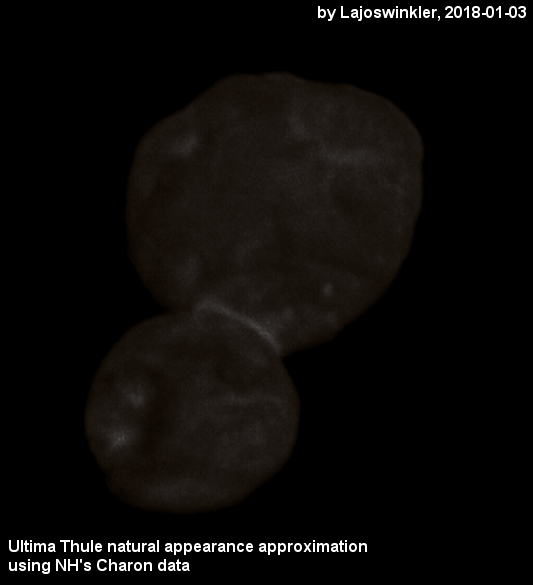
This is excellent! For an object that's darker than asphalt in some places, I think you've done a good job representing what MU69 might look like to human eyes. Color looks very close to the dark patches on both Pluto and Charon. It'll be exciting to see if this expectation holds true as new data is down-linked and released to the public.
13 hours ago, tater said:Generally for icy planets the lower limit for hydrostatic equilibrium is on the order of 200km diameter as I recall. The bulk modulus of the material they are composed of still matters, but things a few km across simply aren't massive enough for gravity to achieve sphericity from itself alone. Planetesimals and cometesimal formation is obviously not super well understood, particularly at small sizes. We're basically now seeing the first such objects in situ. UT, plus Pluto's moons; Styx, Kerberos, Nix, and Hydra. Of the later, 2-3 of them might well be 2 merged bodies, so maybe such low-speed collisions and merging are relatively common.
Bi-lobed bodies appear to be very common in the solar system. Not just MU69 and Pluto's moons, but also several comets: 67P/C-G, 1P/Halley, 19P/Borelly, 103P/Hartley... etc.
This paper suggests that these kinds of bodies actually form this way, precipitating as a binary pair and then eventually collapsing due to orbital decay to form the bi-lobed shape we see today. Such collisions would have happened at incredibly low velocities. On the order of 70-90 cm/s, a little over half the average human walking speed. (Drawing by James Tuttle Keane)

As mentioned by @lajoswinkler these bodies have the consistency of graupel. They're like the outer solar system's version of "rubble piles" a la Ryugu or Bennu. These pairs likely would accrete into a single mass if their interiors hadn't undergone sufficient cohesion yet. For bi-lobes like MU69 or 67P, this suggest there was quite some time between the formation and the collapse of the binary pair. Long enough for radioactive heating to reinforce the interiors of the two lobes, at least.
-
4 hours ago, lajoswinkler said:
Folks, remember that this "red" they're talking about is not our red. It's "it has prominent red spectral lines". (and they always forget that public is not composed out of geologists and that they should adapt to this situation instead of introducing errors like they did with Pluto's image)
Remember Charon's pole?

Left is true color, left is New Horizon's team's "enhanced".
Ultima Thule is not obviously red. It's brownish and quite dark, plus the light there is something like our moonlight. I'll say like chernozem.

This is a good point about the current color images of MU69. The "enhanced" images are false color images that include wavelengths the human eye can't detect. Assembled from Near-Infrared, Red and Blue filter images. (NIR data assigned to the red channel, Red data assigned to the green channel, Blue data assigned to the blue channel). I produced a graphic illustrating this a little while ago using New Horizon's MVIC data and images from Himawari 9's AHI. (All processing by me so any errors are my own)
"Natural" Color*
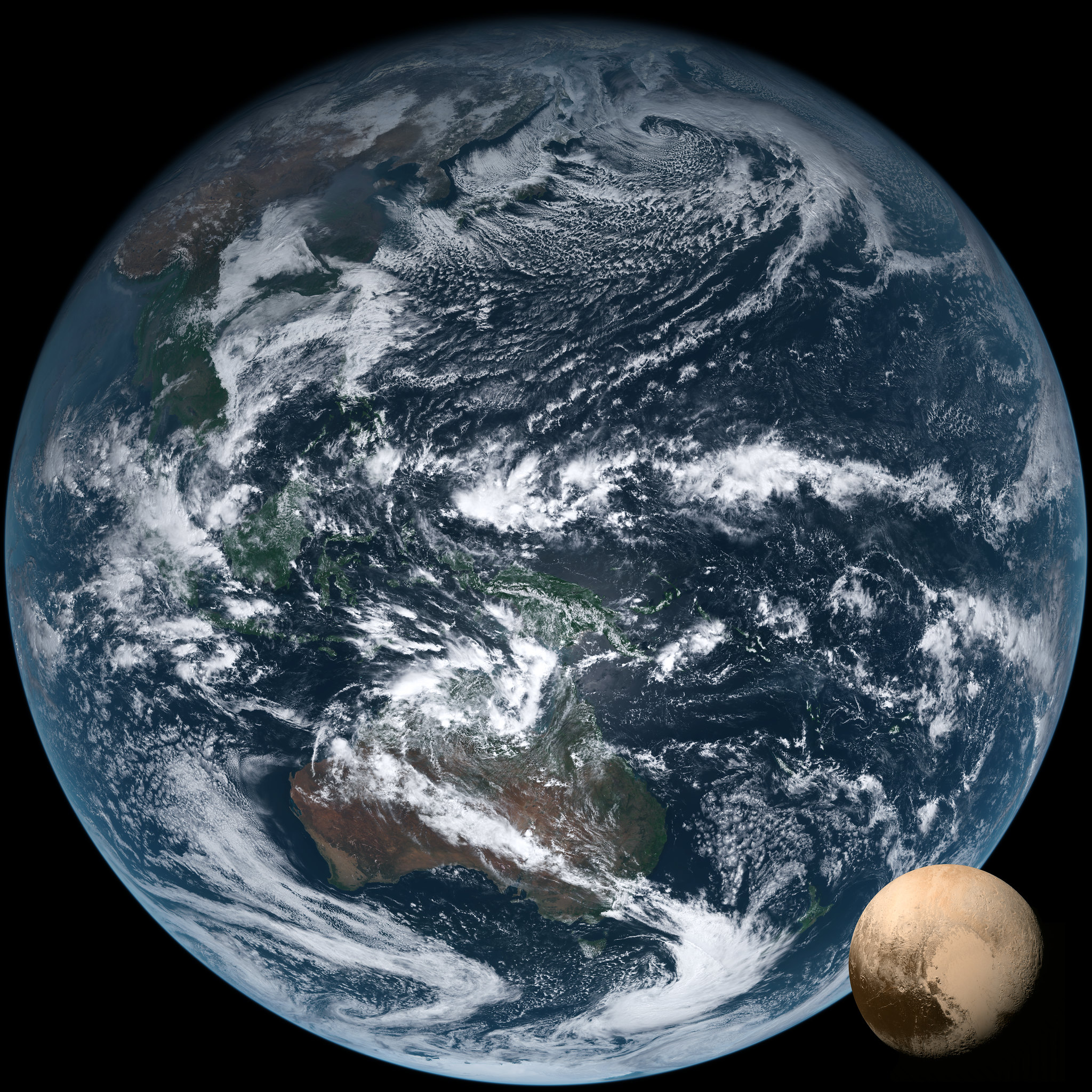
vs
New Horizon's "Enhanced Color"
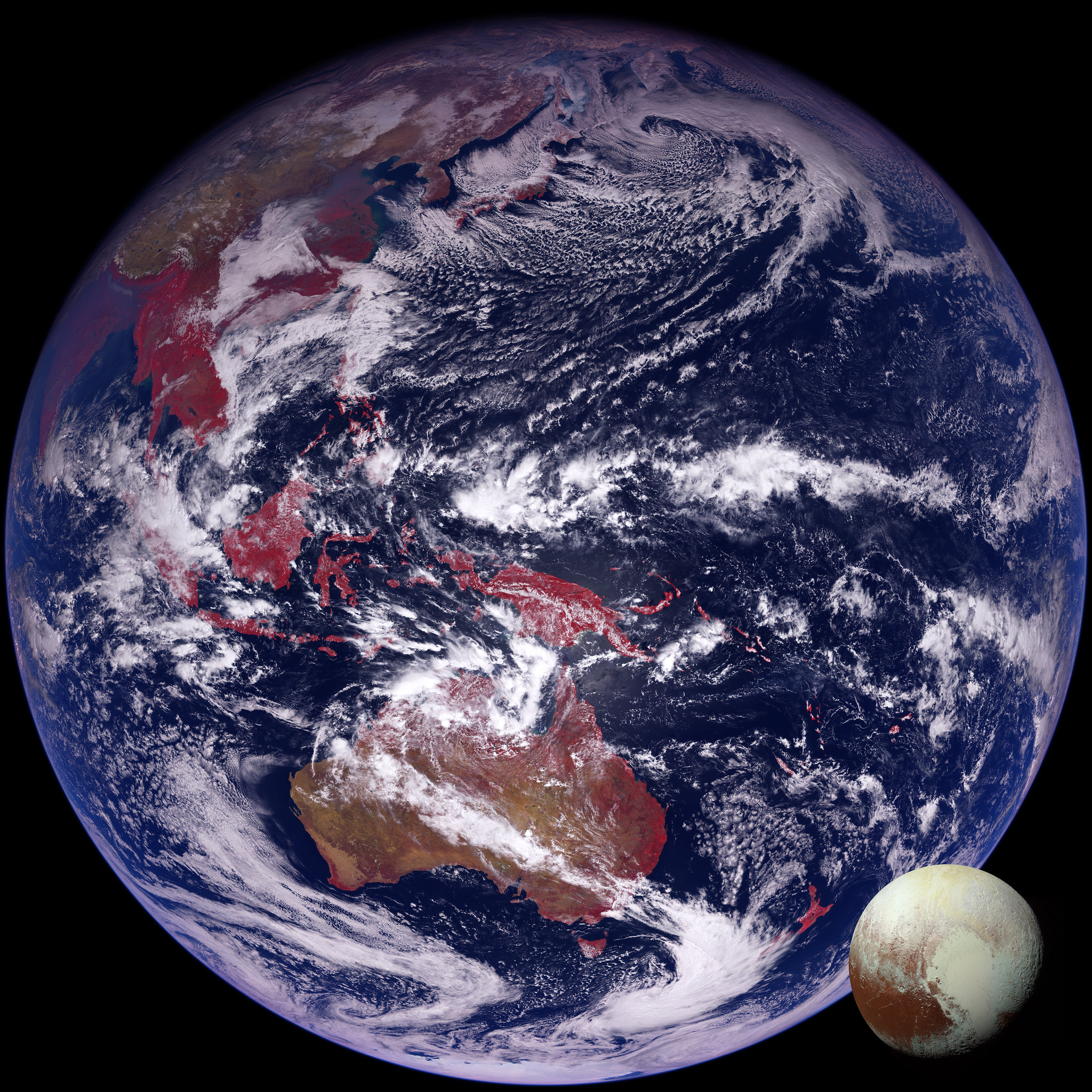
*Note that the "natural color" images still aren't a perfect representation of what the human eye would see. The green filter of Himawari 9's AHI has a different green spectral response than the human eye and Near-infrared data had to be blended in to the green channel order to bring some green back to Earth's vegetation. New Horizons' MVIC doesn't have a green filter at all. The green channel was synthesized by combining blue and red filter images. But all in all they should be at least a close-ish representation of what the human eye would see.**
**My interpretation of Pluto is still a little on the brown/red end. I haven't had time to update these graphics so defer to these images by Alex Parker for a better "natural color" interpretation of Pluto:
https://twitter.com/Alex_Parker/status/102032630097883955
-
On 12/7/2018 at 6:13 PM, Reactordrone said:
Very nice. I manged to get a quick look at 46P Wirtanen on the 15th of November. Hoping for some clear skies here now that it's getting brighter.
-snip-
Great shot!
On 12/7/2018 at 8:23 AM, cubinator said:Those are some great shots of the GEO satellites!
Thank you!
Another, better shot of 46P/Wirtanen taken on 12-11. Was more prepared to shoot in the cold this time. Definitely getting closer and brighter now. Was able to spot it with averted vision on the night I shot this. Last night when I was watching the Geminids with my GF I was able to spot it clearly even with the Moon. Fingers and toes crossed for clear skies and good seeing on the 16th. Weather has taken quite a wintry turn as of late, this might end up being my best shot of comet Wirtanen. On the plus side, taking advantage of every clear sky I get has given me an excuse to try out the new tripod I got for Christmas early. Naughty me.

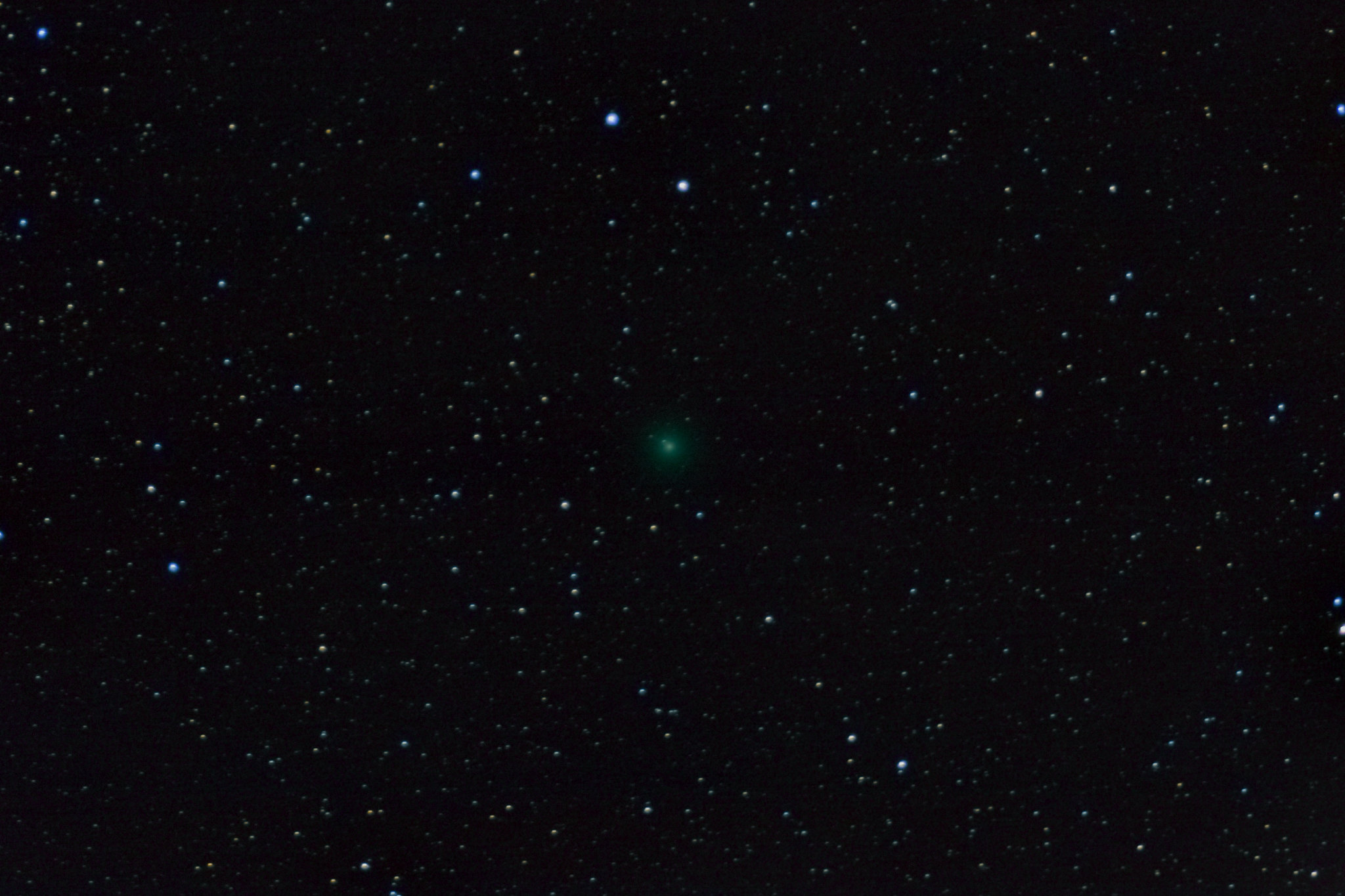
Image Details:
SpoilerComet Wirtanen approaching perihelion on 12-11. The comet is now naked-eye visible. It's possible to sight it clearly as a faint-fuzzy patch even under a moonlit sky. It stands out ever clearer using averted vision. No visible color yet, though it does show up strongly on long-exposure photographs. The blue-green color is due to strong emission of Cyanogen [ (CN)₂ ] and diatomic Carbon. (C₂)
Gear Used:
- Camera - Canon EOS 350D
- Lens - Canon EF 75-300mm
- Tripod - Pedco Ultrapod II
Acquisition Details:
- 91x6" sub exposures
- 9.1 minutes total integration time
- f/4
- ISO-1600
- 75mm focal length
Software:
- Adobe Camera Raw
- DeepSkyStacker
- Adobe Photoshop CS5.1
Processing Details:
Noise reduction, lens correction and a linear tone curve applied in Adobe Camera Raw. Images converted to lossless TIF format and then stacked in Deep Sky Stacker using Stars + Comet Stacking, Kappa-Sigma Clipping and 2x Drizzle. Final stack sent to Photoshop for gradient removal, color correction and a nonlinear stretch. HLVG plugin was applied on "weak" settings to remove the green cast on some stars, comet was masked so green reduction was less in that area. Image finally had a saturation boost applied and was cropped slightly.
Fullres: https://flic.kr/p/2cti5Mw
-
Modded some space potatoes into the game.
Tsyke, a big metal asteroid supposed to be an analogue to the IRL asteroid 16 Psyche.
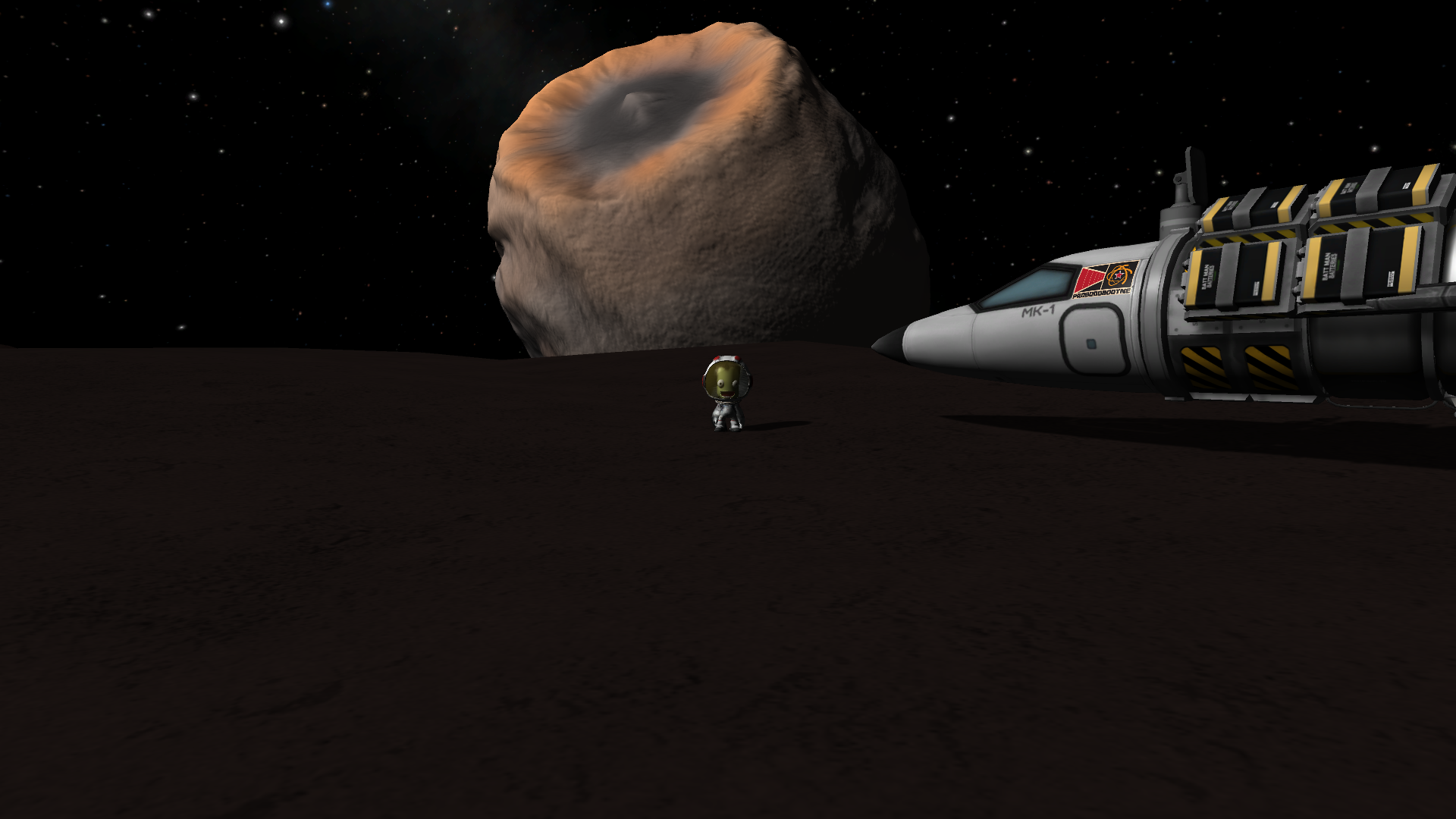
Ridge, a tiny moonlet in a placeholder orbit around Tsyke until I can figure out where to put it. Only 2.4 km across. Shaped like a ravioli.
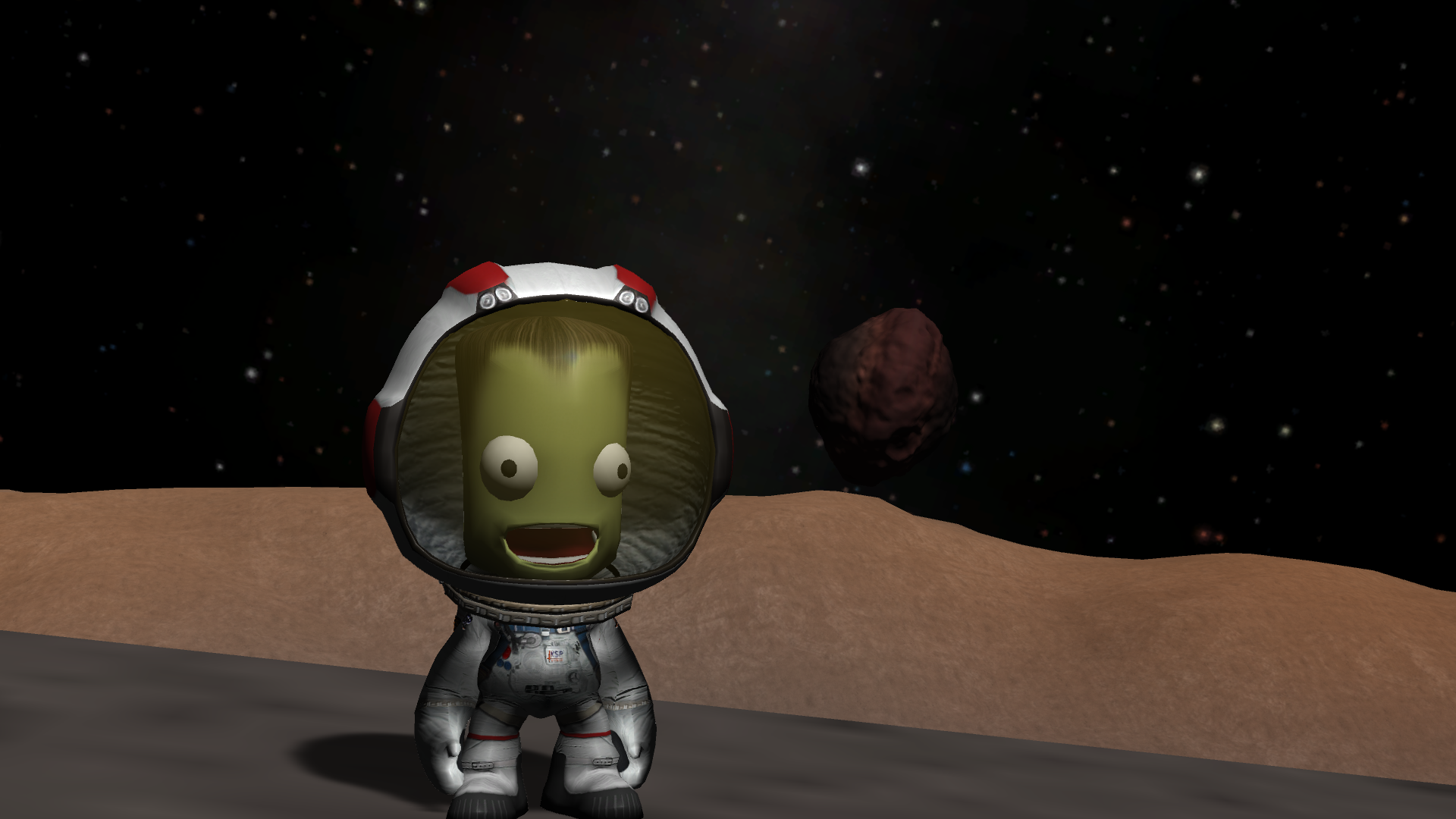
Trojar, a Jool Trojan asteroid. Haven't got the orbit right yet but it should work when I do. Especially with the Principia mod maybe.
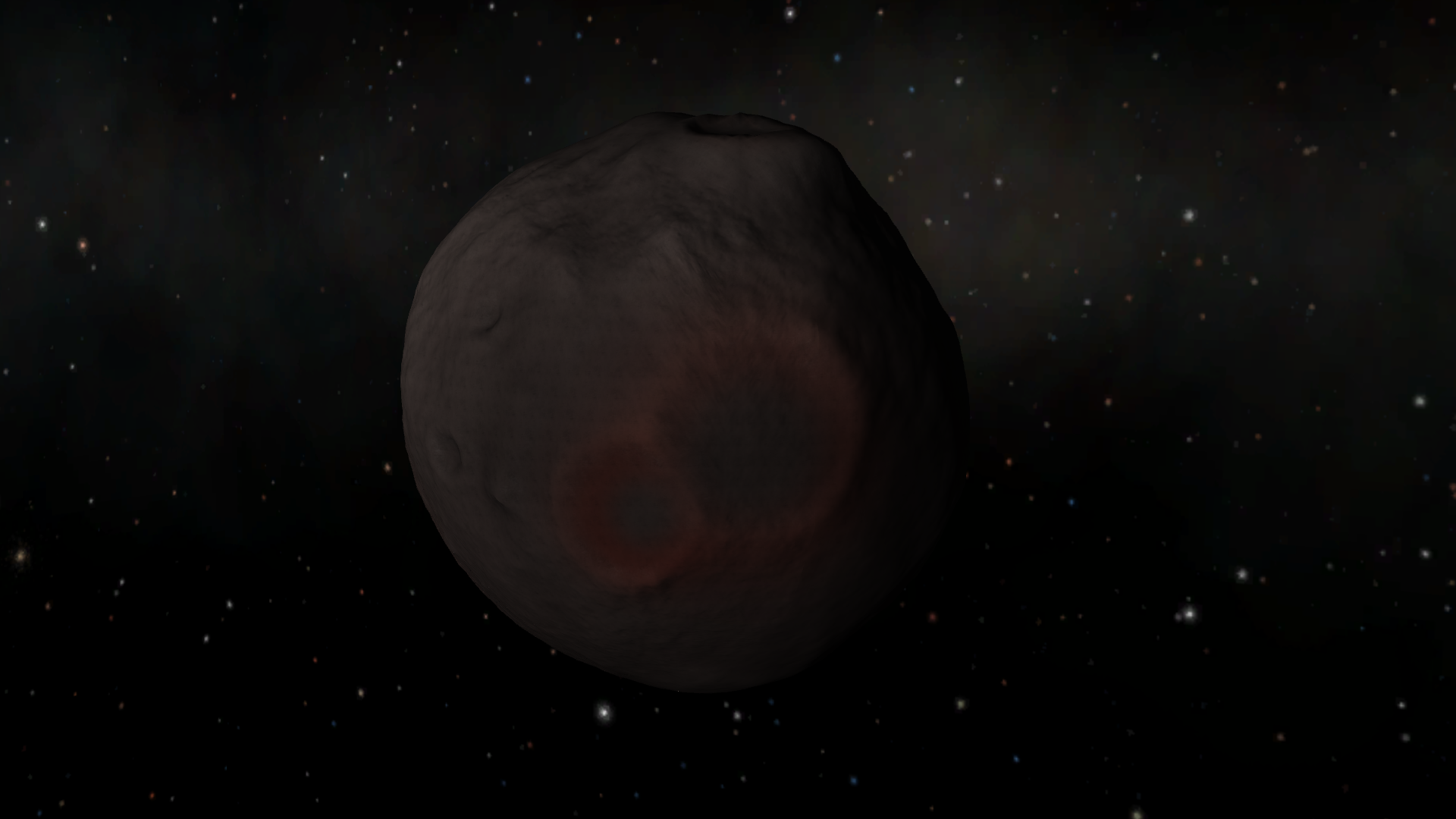
Jeb discovered that Trojar has a big hole in it like the Mohole. Perfect for throwing sacrifices to the Kraken in.
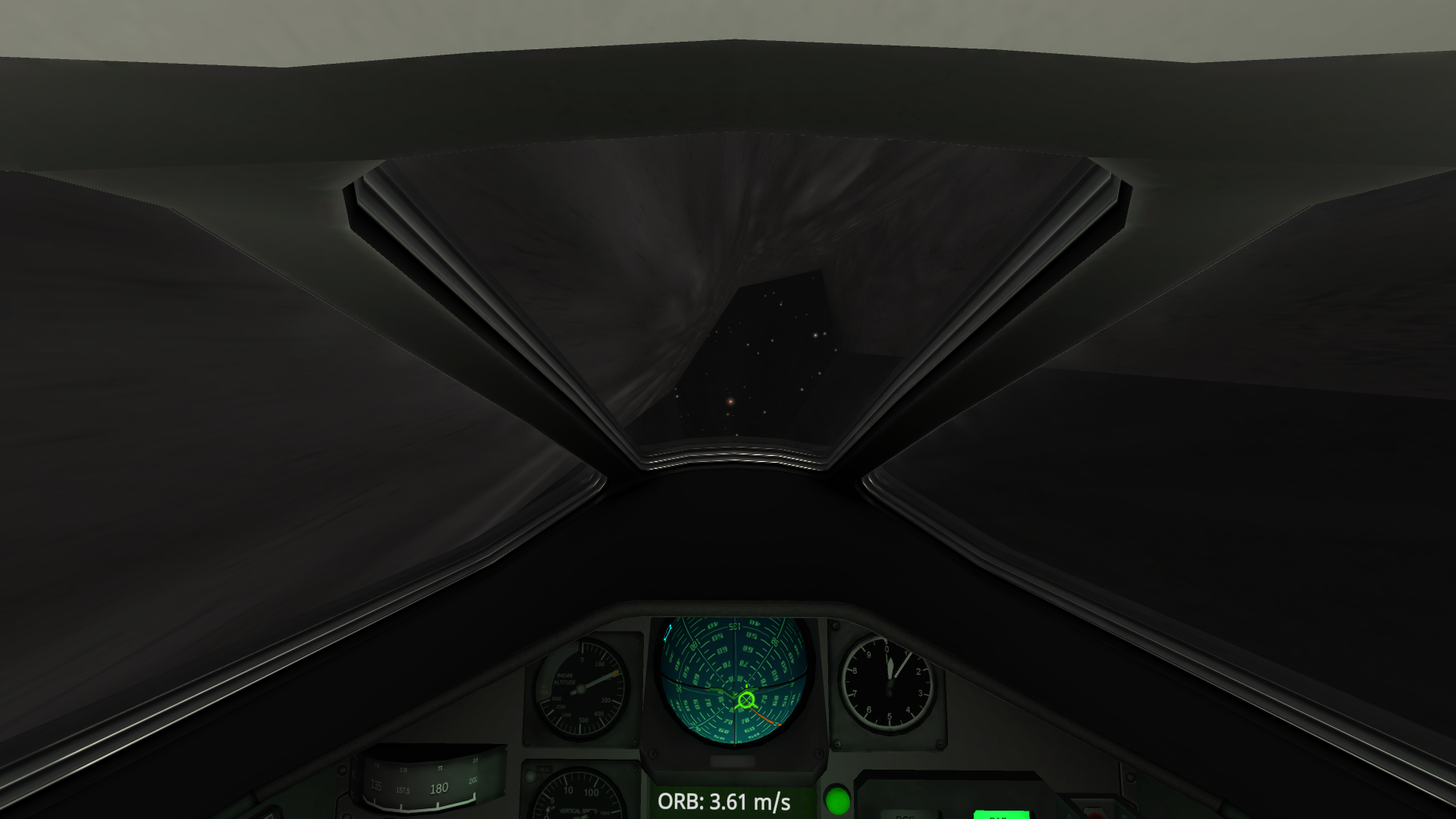
Sacrifice: One (1) Kerbug-I and one (1) Jebediah Kerman. Hopefully the Kraken finds it worthy.
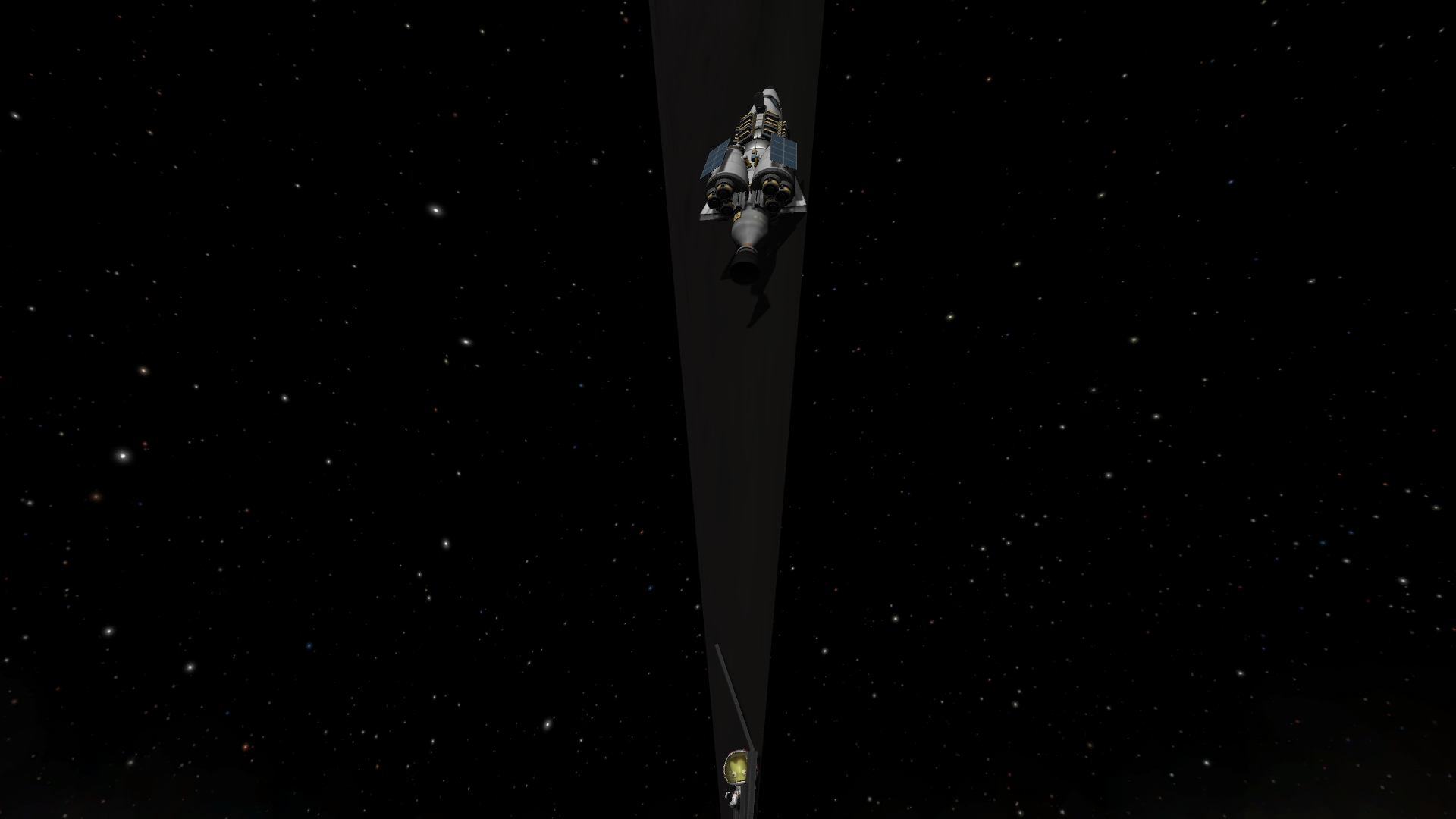
Suddenly, it happens. Jeb begins to vibrate violently as he phases out of existence! The Kraken is pleased.
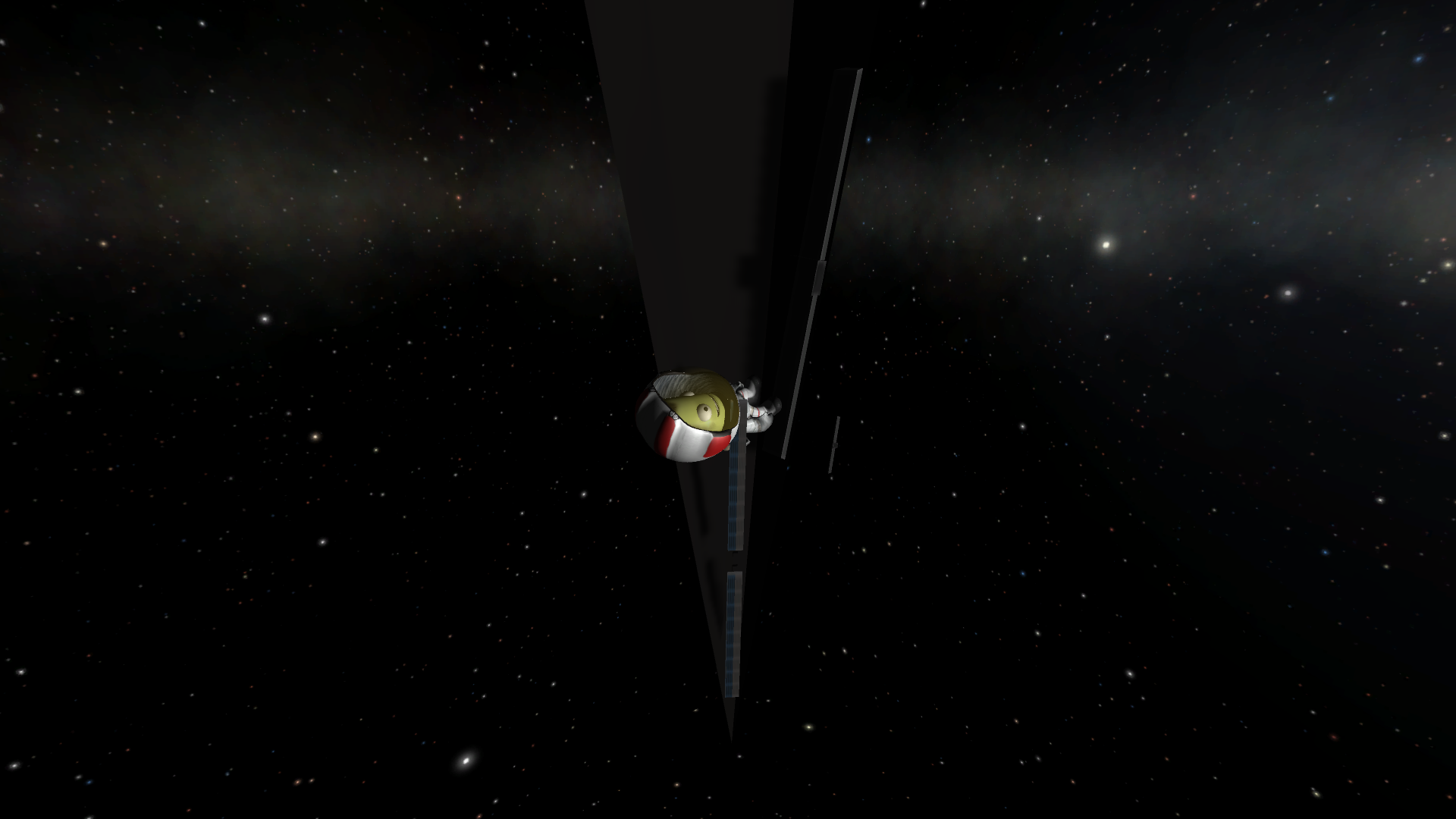
"Gene, I don't feel so good" - Jeb Kerman to Mission Control
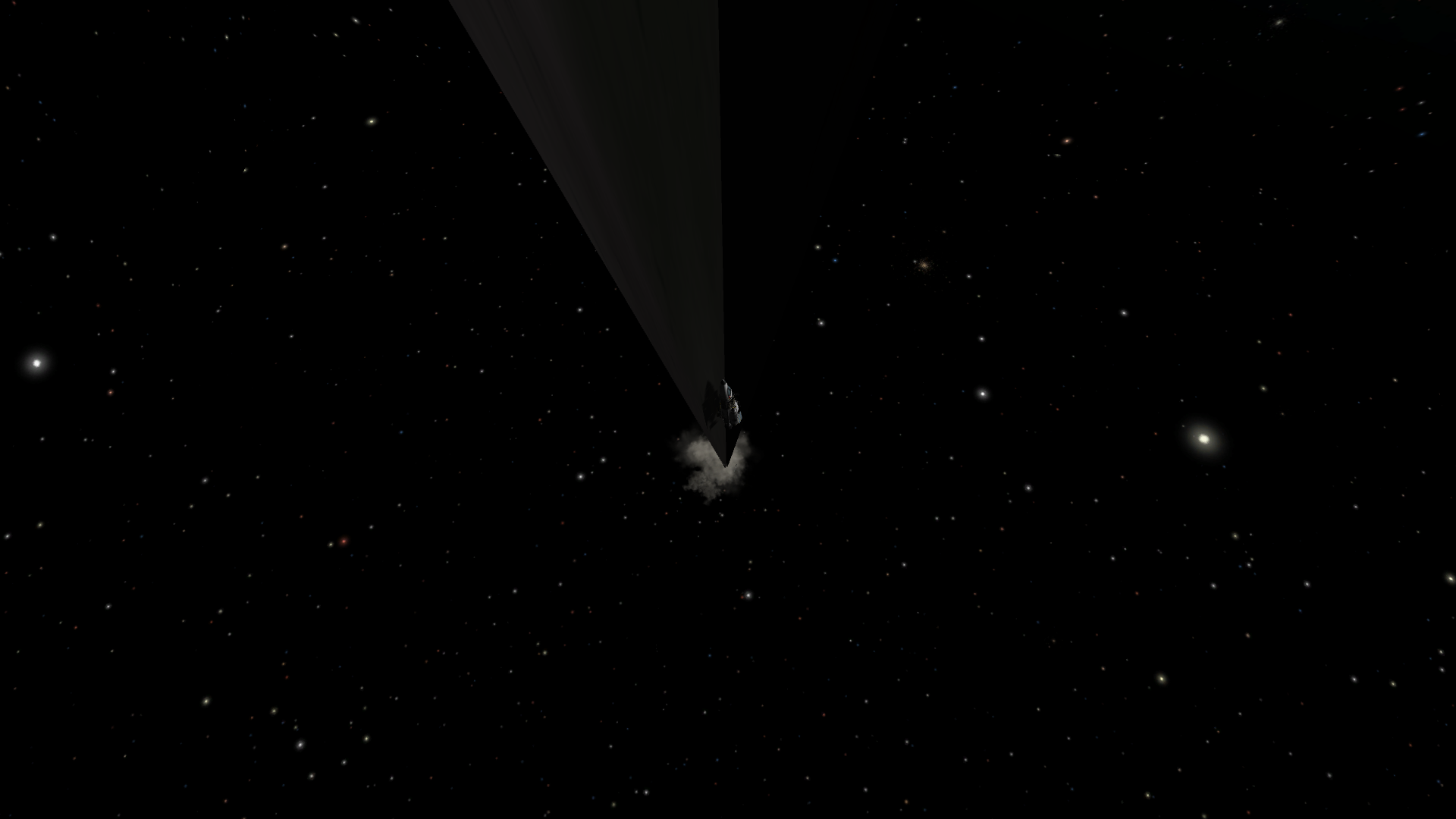
-
Hi, I'd like to have my name changed to LaydeeDem please. I'd very much appreciate it.
-
Fixing the memory problems would be nice.
-
-
On 11/27/2018 at 12:34 PM, Green Baron said:
"Oh, it is halfsun again. How time flies ..." :-)
Using the Gemini Planet Imager and the VLTI Sphere instrument, the shadows of a binary star system on a protoplanetary disk have been mapped in a system 73pc from here (V4046 Sgr), including phases.
I only found an italian popscience article.
Here is a sketchy sketch of what i mean, but don't take it too serious. The differences are by far not as abrupt and symmetric as shown:
Link to the paper on a site that isn't blocked by a paywall: https://arxiv.org/pdf/1811.10621.pdf

Interesting stuff.

-
Lots of clouds and frigid temperatures lately, but I managed to catch a break with clear skies the last two nights.
Managed to catch comet 46P/Wirtanen on its way towards perihelion on 12-4. According to CalSky it was at magnitude 6.1, just outside the visual range for most people's eyes. Thought I might have sighted it visually with averted vision, though I was likely seeing the nearby 5th-magnitude stars or fog on my glasses lol.
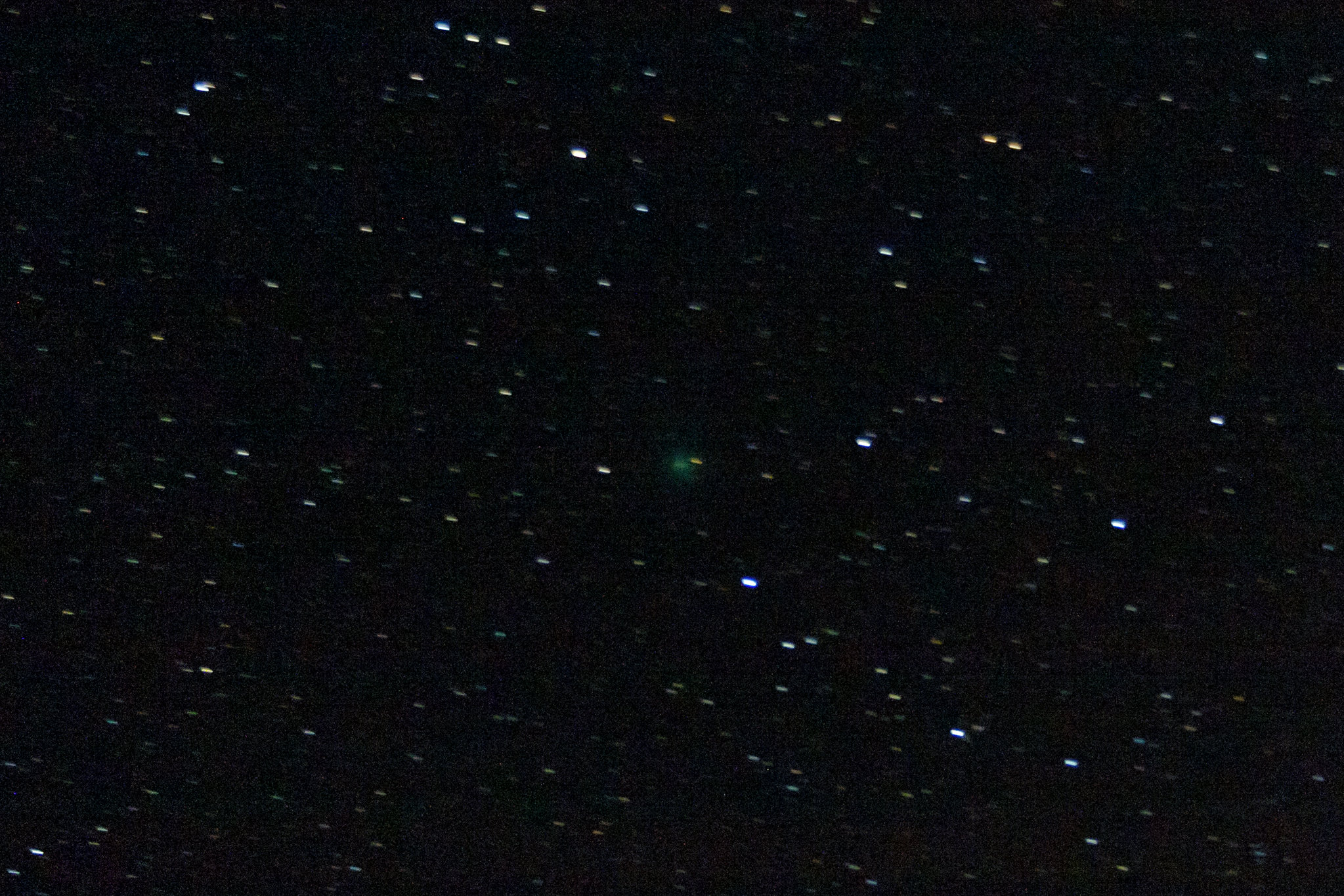
Image details:
SpoilerGear used:
Camera - Canon EOS 350D
Lens - Canon EF-S 18-55mmAcquisition Details:
8x30" sub exposures
ISO 1600
55mm focal length
f/5.6Processing Details
Lens corrections applied and sub frames converted to lossless TIF using Adobe Camera Raw. Subframes stacked with Deep Sky Stacker using Kappa Sigma Clipping and 2x Drizzle. Color correction, gradient removal, stretching, saturation enhancement and significant cropping done in Adobe Photoshop.
Notes:
Trailing is worse than usual. I was not prepared for the biting cold and the tiny aperture of my wide lens made star-hopping a complete pain. I did not have the patience required to shoot many short exposures to avoid trailing so I shot only a few long exposures just to say that I captured the comet. Now that I've brought the winter clothes out of the closet I should be more prepared to capture a better image when 46P reaches perihelion. (Crossing fingers for a clear night!)
Fullres: https://flic.kr/p/RevdQj
The next night I was more prepared to shoot in the cold. Some high altitude clouds were blocking Wirtanen so I turned my sights towards Orion. Used my faster, longer focal length lens to try and capture some of the nebulae in the belt and sword regions of Orion. Managed to catch the Flame Nebula (NGC 2024), the Running Man (NGC 1977) and the Great Orion Nebula (M42). Thought I might have gotten hints of the Horsehead however it's so faint it's hard to distinguish it from the splotchy artifacts that appear in other low-signal areas.

Image Details:
SpoilerGear Used:
Camera - Canon EOS 350D
Lens - Canon EF 75-300mm
Mount - TripodAcquisition Details:
66x6" sub exposures
6.6 minutes total integration time
75mm focal length
ISO-1600
f/4Software Used:
Adobe Camera Raw
Deep Sky Stacker
Adobe Photoshop
rnc-colorstretchProcessing Details:
Raw images lens corrected and converted to lossless TIF in Adobe Camera Raw, sub frames then stacked in Deep Sky Stacker using Kappa-Sigma Clipping and 2x Drizzle. Resulting stack was loaded into Photoshop for further correction of chromatic abberation using the "purple fringe killer" action set. Image saved as lossless PNG and sent through Roger Clark's rnc-colorstretch tool. Stretched image was sent to Adobe Photoshop for final color correction, localized saturation enhancement on the nebulae and a 2x crop.Fullres: https://flic.kr/p/PCxm7r
After taking a satisfying amount of images at a wide focal length, I centered my camera on M42 and zoomed to 300mm focal length for some satellite hunting. Geostationary satellites often cross in front of M42 so I took a series of long exposure "star trail" images in an attempt to find some. I managed to find four, along with another sat I couldn't identify.
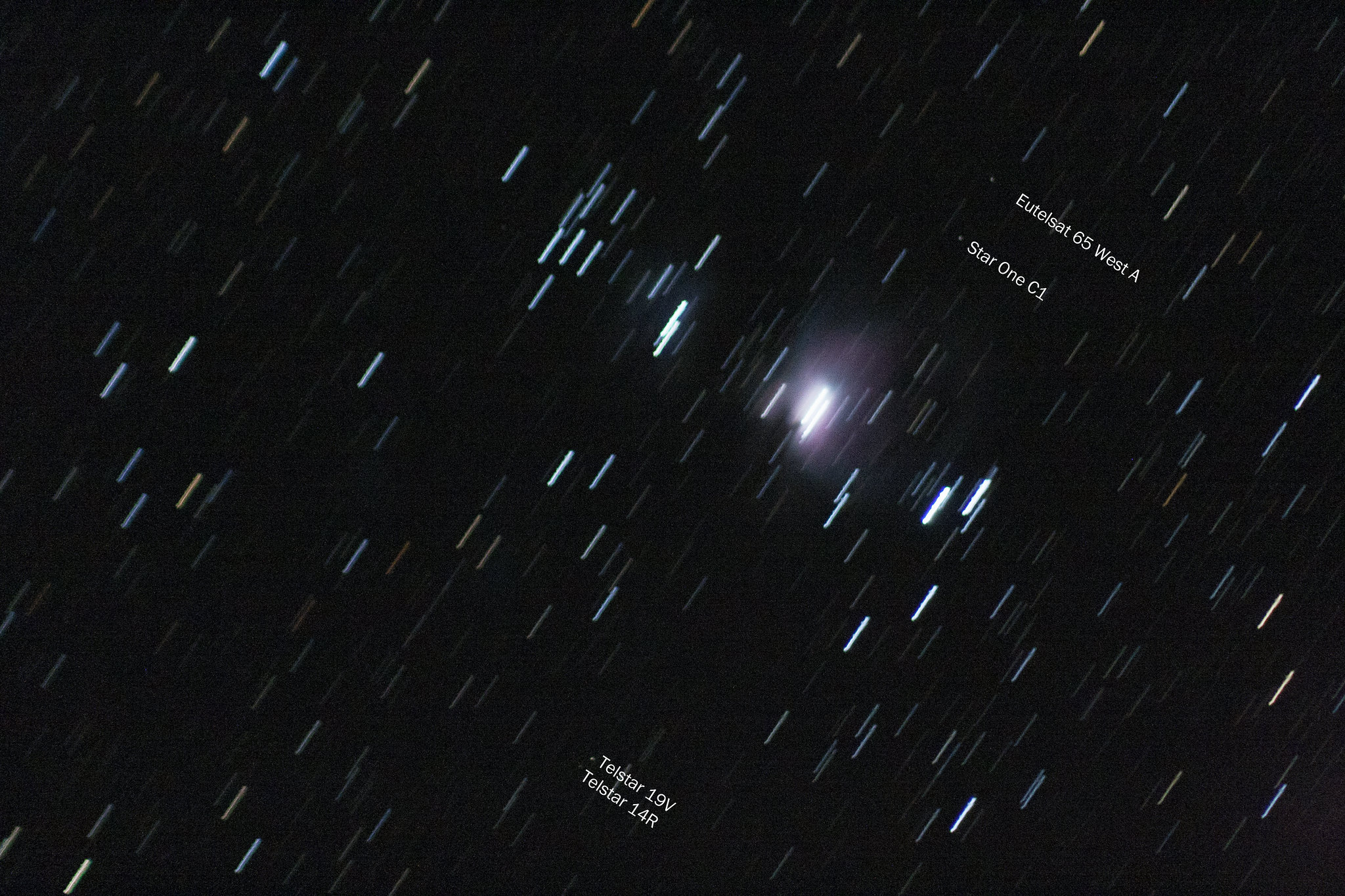
Same as before but in timelapse video format. Includes the unidentified sat:
Image Details:
SpoilerGear Used:
Camera - Canon EOS 350D
Lens - Canon EF 75-300mmAquisition:
Single 30" exposure
300mm focal length
ISO-1600
f/5.6Processing:
Raw converted in Adobe Camera raw. Color correction, levels adjustment and satellite labels done in Adobe Photoshop.Video timelapse frames exported as image sequence, stitched frames together into an AVI video using VirtualDub. Final presentation done in Sony Vegas.
Misc:
Satellites identified using Stellarium and the UCS Satellite database: https://www.ucsusa.org/nuclear-weapons/space-weapons/satellite-databaseFullres Still Image:
https://flic.kr/p/2djdGFuCheers.

-
Needed to put a probe in a <60 degree orbit around the Sun. So I put my smallest probe on my biggest rocket and sent it towards Jool. This makes the first interplanetary mission for my career mode save. (1.4.5)
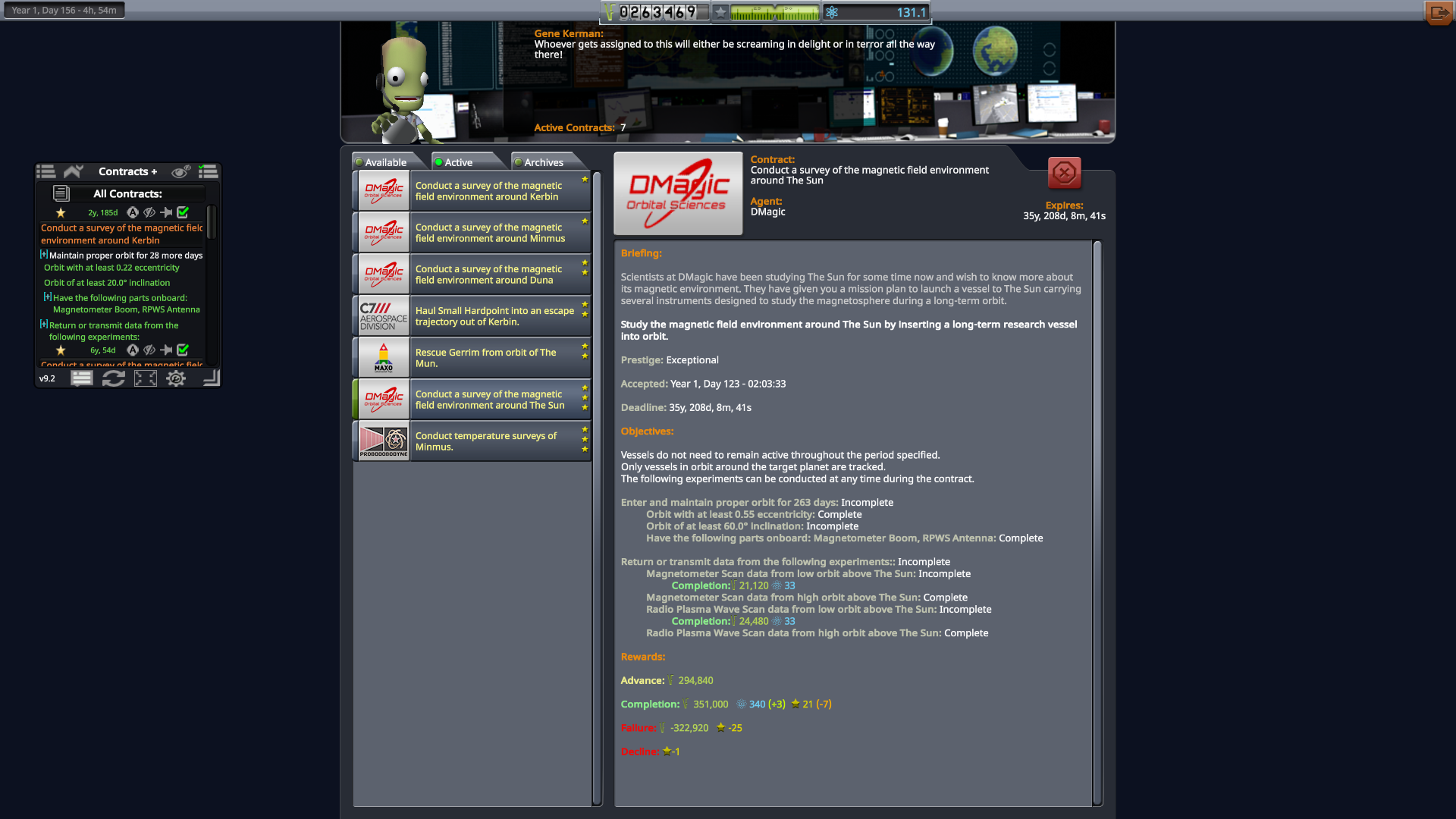
The Juno-II Heavy on the pad with KERMES (KERbol Magnetic Environment Sensor)
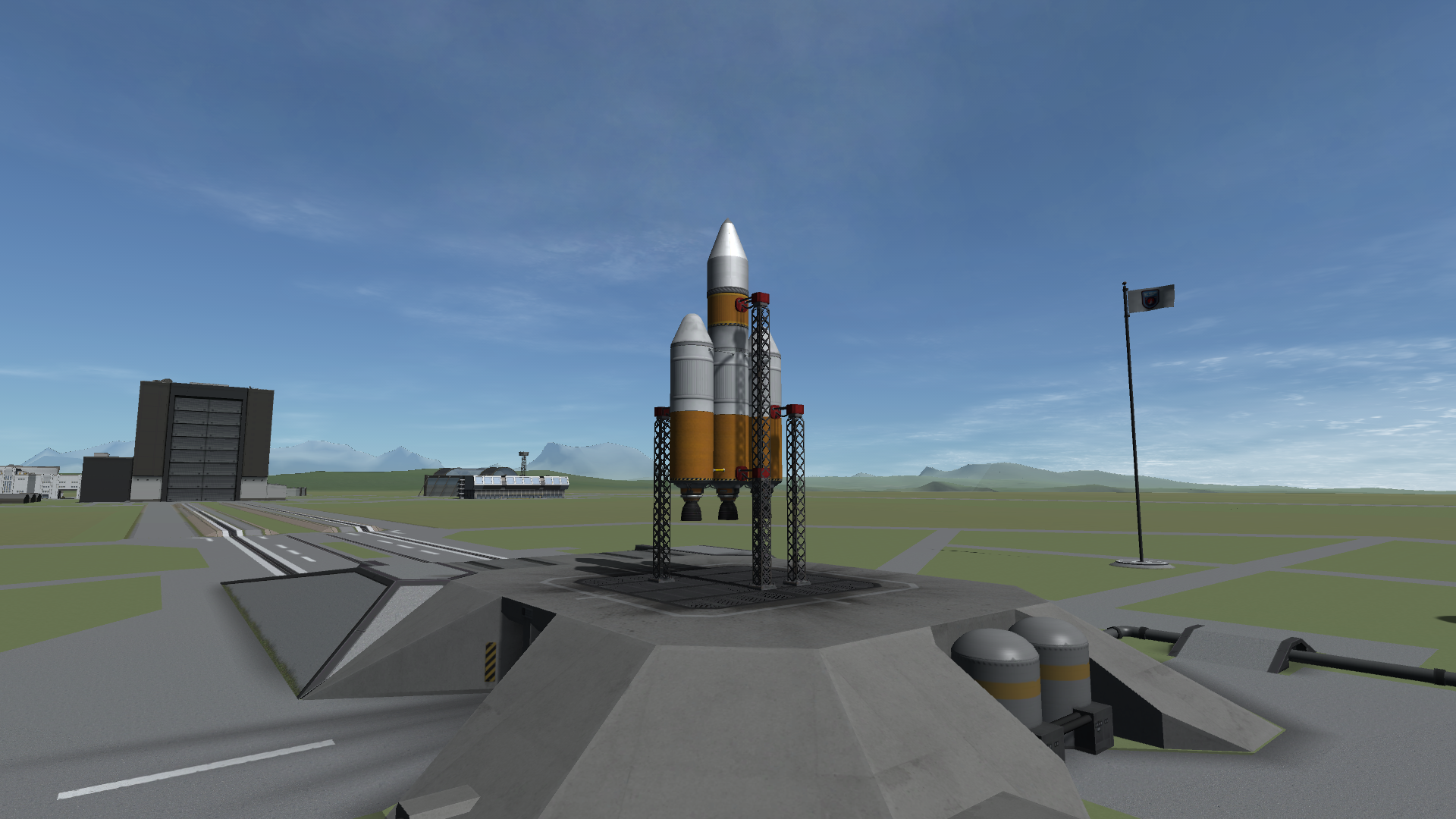
Fairing Sep:
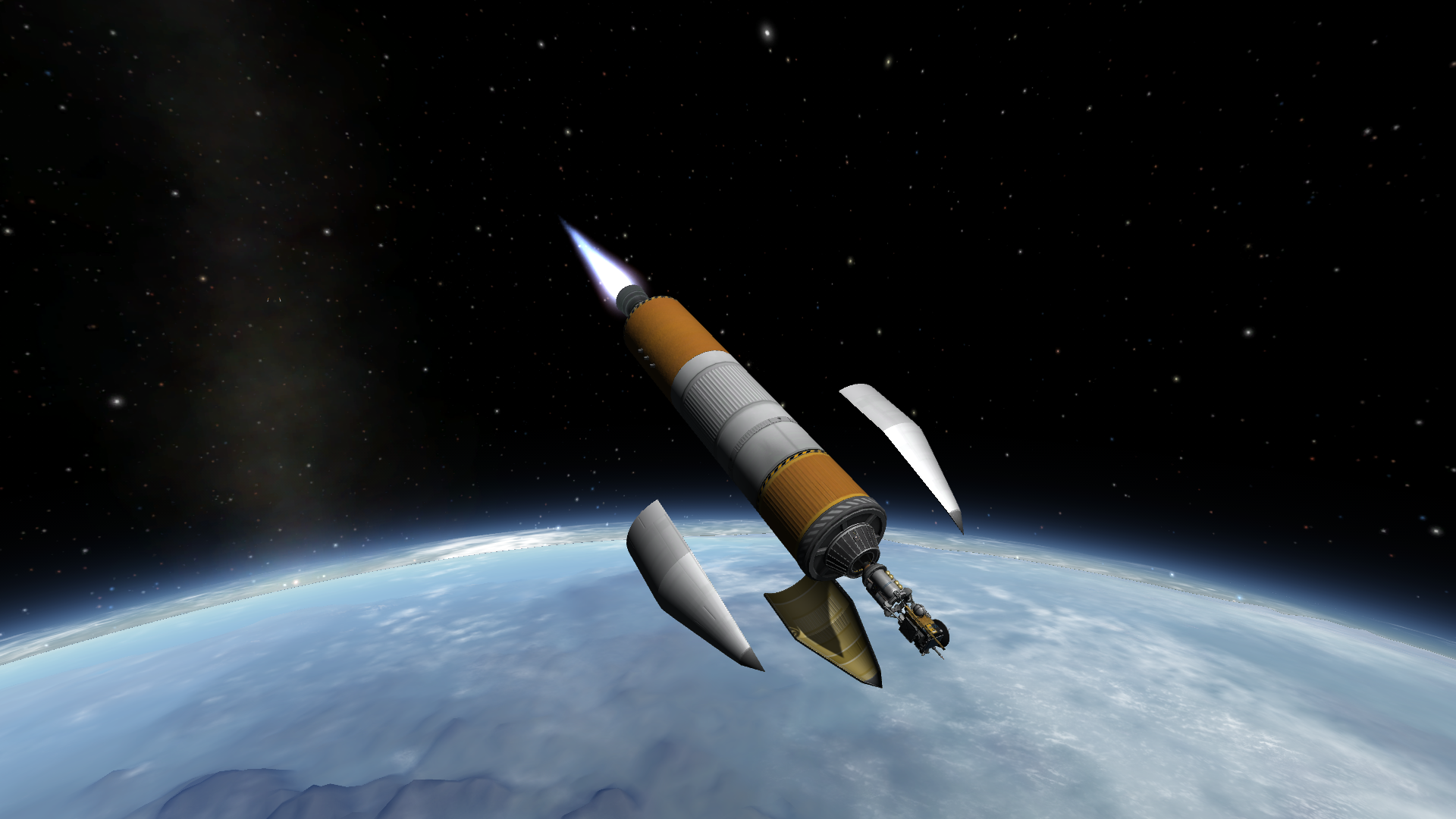
KERMES after TJI flying near the Mun:
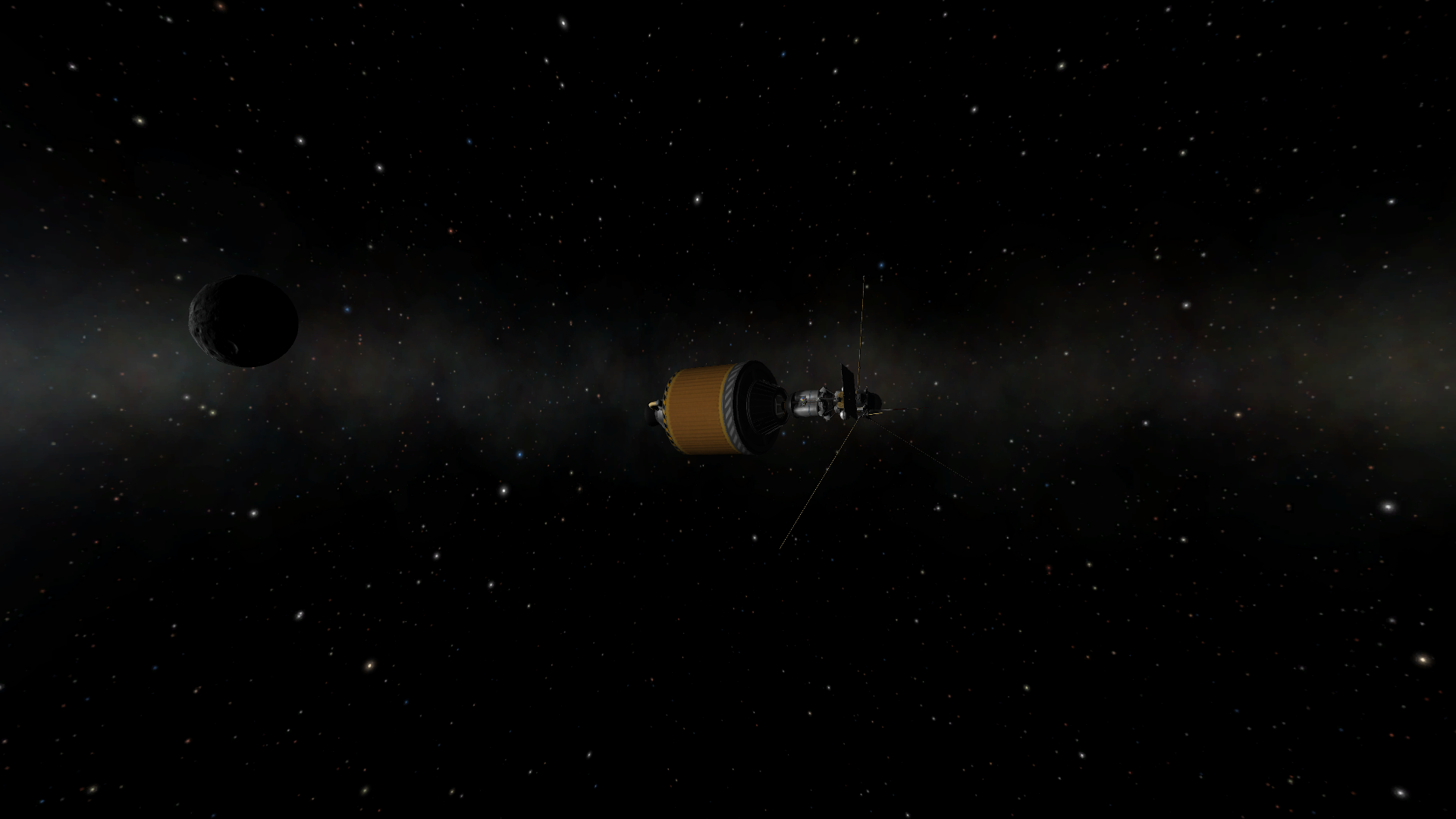
TJI occured at a less-than-optimal phase angle, however the craft contains enough dV to cover for any losses that might of incurred.
Final trajectory: (Principia nearly grinds KSP to a halt rendering orbits this long in period. My poor computer!)
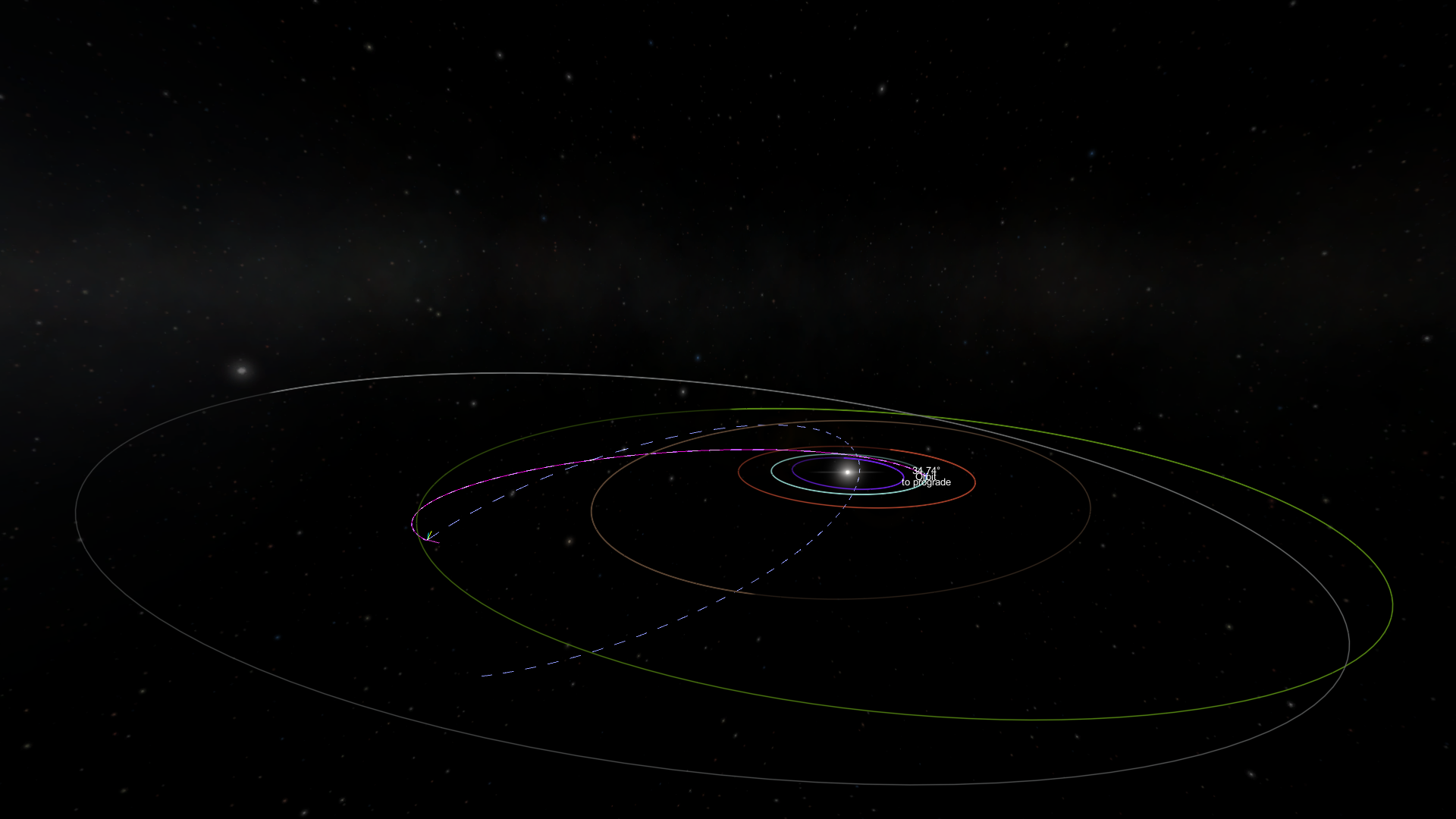
Hopefully the probe has enough EC and comms to communicate once at Jool. It'll be vital for the maneuver at Jool periapsis and for collecting sweet science from the planet while we're there.
-
Another Moonshot. More adventures in pulling detail out of my tiny 300mm lens.


Image Info:
The Moon on 11/14/18. Image is nearly true color, but the saturation has been boosted significantly to show subtle color variations in the Lunar surface. Blue regions, like the Sea of Tranquility, are more rich in titanium, while red areas are titanium-poor and contain iron.
Acquisition and processing details:
SpoilerProcessing:
Adobe Camera Raw - Raw conversion, lens correction, noise removal
PIPP - Alignment and slight cropping
AutoStakkert! 2 - Stacked best 90% of 51 frames, 1.5x drizzle
Registax - Wavelet sharpening, RGB balance.
Adobe Photoshop - Final color correction with curves tool, green channel replaced with a synthetic green channel using the channel mixer, (50% R + 50% B), saturation boosted significantly, image rotated, cropped and a slight contrast stretch applied. Image resized 2x.
Processing steps in GIF form: (You can really see just how little starting detail I have to work with here! Autostakkert's drizzle is like magic.)

Gear:
Canon EOS 350D
Canon EF-S 75-300mm lens
Acquisition:
300mm focal length
f/11
ISO 800
51 x 1/800" lights
Taken at 7:09 local time on 11/14/18
-
54 minutes ago, DDE said:
Does it actually favour Neowise or does it favour Neowise because they copy-paste those numbers?
They look copied because they are, but not due to fraud. Read my previous post:
On 11/17/2018 at 6:38 PM, Nutt007 said:Fascinating, but after reading more on this, I'm not sure Dr. Myrvold's claims and (very serious) accusations hold weight.
Some relevant information:
- Myrvold's model fails to predict the diameters of asteroids with known size.
- Data from IRAS and the Japanese Akari spacecraft corroborate the NEOWISE team's results
- Ground-based occultation data corroborates the NEOWISE team's results, not Myrvold's
- His claims of fraud are unfounded, unprofessional, and more importantly, wrong. Including results from other observations to improve the accuracy of the model =! fraud.
Now, I'm even more of an armchair astronomer than Myrvold, the extent of my knowledge is a semester of Astronomy 101 and some books on amateur differential photometry, but if you want my uneducated opinion as a layperson:
He's wrong, and like other "contrarians" (wannabe Galileo's imo), suffers from the Dunning-Kruger effect and believes himself to be more qualified than the people who actually spend their lives studying what he's critiquing. His paper can be summed up as an error-riddled complaint about "spherical cows". Asteroids have incredibly complex surfaces. Of course the NEOWISE team's model simplifies things. The team is well aware of the simplifications they're making. The question then is whether the model approximates reality. And it does, pretty well.
They're using other, non-infrared observations to build and refine their model. The technique is discussed in great detail here and cited in several subsequent papers. A little weird that the NEOWISE team would so openly discuss their "scientific misconduct".
-
17 hours ago, kerbiloid said:
Dinokillaz relate to both dinos and their killers.
When I was helping with a fuel storage calculations (irl), we found enormous amount of obvious mistakes in official standard tables. Up to several per page.
All those tables were calculated by professionals or students told by the professionals to do that.
The difference is: you can always measure a tank with a rope, but you have to believe the professionals talking about asteroids.
Upd.
Another nice sample which shocked me when I was a pupil: a book about SDI (star wars) with a lot of formulas, etc, written (officially) by several professors and doctors, where several formulas just were partially inverted (even dimensions were wrong). I had a continuous headache trying to get the same results from the same numbers until I realized that.If some work is done by a professional, do not be too much sure that he hadn't pinned the routine work on his lazy or fool apprentices.
And obviously he hadn't then checked every number humself.Upd2.
I won't tell about some local scientific researches about natural spa properties which I was helping with.I'm not trying to say that professionals or even scientific consensus is infallible. But if your goal is to upend the current line of thinking, you better do a darn good job. From what I've read, Myrvold hasn't. The evidence (Radar images, occultations, spacecraft visits, IRAS data, Akari data) favors NEOWISE.
-
Fascinating, but after reading more on this, I'm not sure Dr. Myrvold's claims and (very serious) accusations hold weight.
Some relevant information:
- Myrvold's model fails to predict the diameters of asteroids with known size.
- Data from IRAS and the Japanese Akari spacecraft corroborate the NEOWISE team's results
- Ground-based occultation data corroborates the NEOWISE team's results, not Myrvold's
- His claims of fraud are unfounded, unprofessional, and more importantly, wrong. Including results from other observations to improve the accuracy of the model =! fraud.
Now, I'm even more of an armchair astronomer than Myrvold, the extent of my knowledge is a semester of Astronomy 101 and some books on amateur differential photometry, but if you want my uneducated opinion as a layperson:
He's wrong, and like other "contrarians" (wannabe Galileo's imo), suffers from the Dunning-Kruger effect and believes himself to be more qualified than the people who actually spend their lives studying what he's critiquing. His paper can be summed up as an error-riddled complaint about "spherical cows". Asteroids have incredibly complex surfaces. Of course the NEOWISE team's model simplifies things. The team is well aware of the simplifications they're making. The question then is whether the model approximates reality. And it does, pretty well.
-
Was reading this one the other day:
"MAGNETOUR:
Surfing Planetary Systems on Electromagnetic and Multi-Body Gravity Fields"
https://www.nasa.gov/sites/default/files/files/Lantoine_2012_Ph1_MAGNETOUR.pdf
-
Direct imaging of an exoplanet's surface is no small feat. It's comparable to observing the Apollo LEM on the Moon from the surface of the Earth. To do it at all requires a massive aperture. To do it and get a reasonable amount of detail requires an even bigger one. However there is a way to do it, and cheaply too! No need for massive mirrors or flying out to 550 AU.

I'm actually surprised Aragoscopes haven't been mentioned yet. Rather than use a mirror as a collecting surface, instead an opaque disk or ring would be deployed in front of the spacecraft. It seems a little counter-intuitive, but since light's wave-like nature causes it to diffract, the brightest part of the shadow is actually in the middle. Place a detector + relevant optics at this spot (the Arago spot), and you've essentially created a telescope for very cheap. It scales too! According to this study, Aragoscopes from 100m to 1,000m were shown to be feasible, with a 100m Aragoscope being possible with what's usually budgeted for flagship class missions (Though we all know from JWST that those estimates tend to be a little low).
But the science it would allow would open up a whole new world of astronomy. A 1km Aragoscope + accompanying Starshade observing in visible light would be able to resolve Jupiter's disk and the Galilean moons from 7 parsecs away. Resolution gets better as you move towards the UV/X-ray end of the spectrum too, so such telescopes could potentially be used to directly image the event horizons of black holes such as Sagittarius A* and the BH in M87. The big issues with this design would be the need for very high-accuracy pointing due to the long focal length and the low contrast created by the obstructing disk. However I think these issues are likely to be solved within the next few decades.
Until then we can watch Cody'sLab at least.

-
On 11/5/2018 at 7:00 AM, Atkara said:
Heh... nowadays you're branded an elitist, just by not using the thing. And don't dare to even imply you don't need it. Sometimes I wonder who really hates whom

I wouldn't call anyone who doesn't use it or doesn't need it elitist. I myself don't use it so that'd be a little silly.
-
Only skimmed through the thread, but I thought I'd throw in my two cents as someone who's been playing since 2011:
When it first came out I used to be really elitist about Mechjeb use. I considered it "cheating" and a "crutch". But through the years I've come to change my opinion:
There's literally nothing wrong with using Mechjeb. To say otherwise is just gatekeeping which is never productive. I really don't see a point in discouraging certain playstyles. It's your game. Play how you like! No one should be able to take that away from you or think less of you because of that.
-
View from my latest resupply mission to Kerbolab:
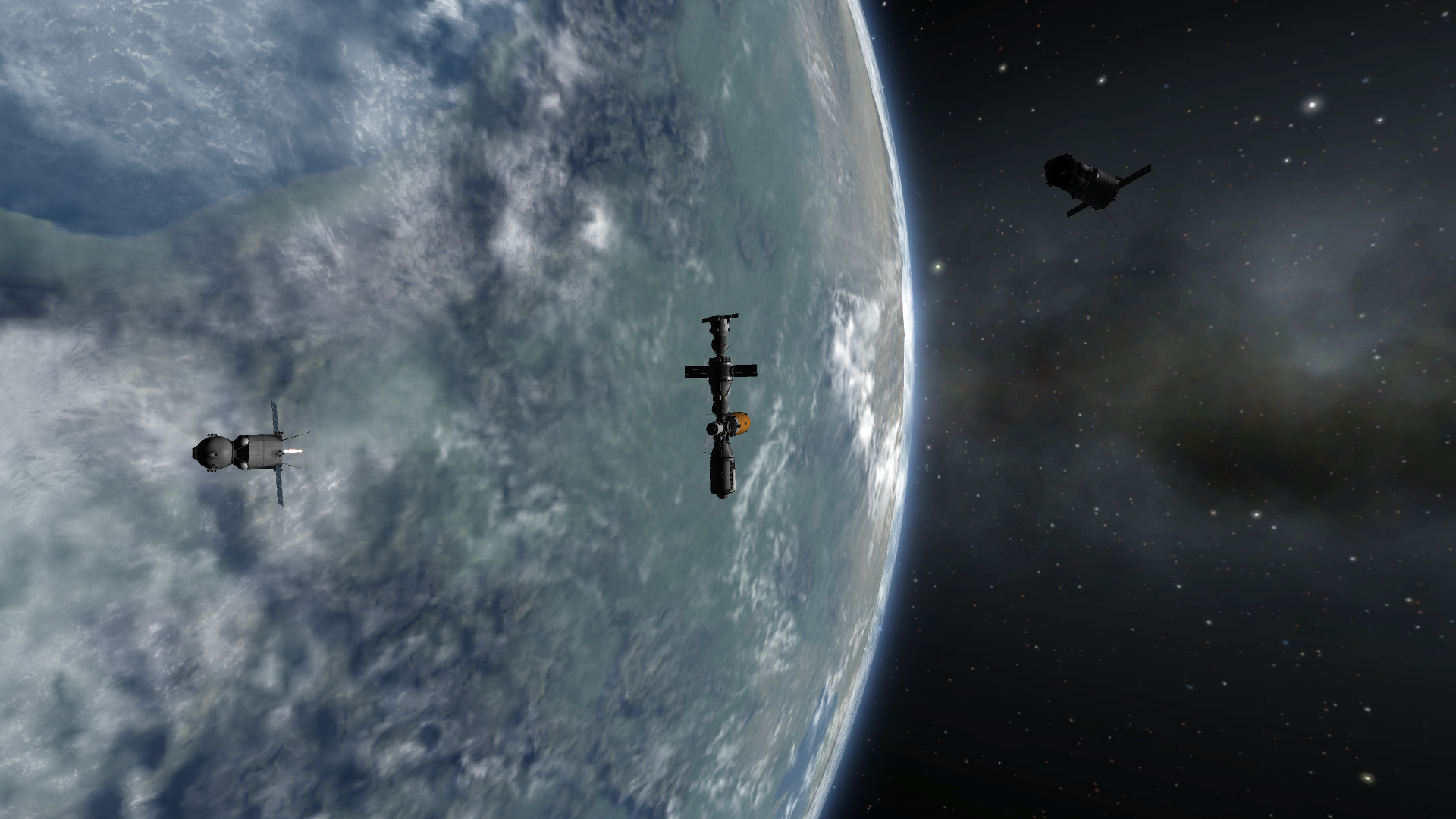







Unknown Facts About Exoplanets
in Science & Spaceflight
Posted · Edited by LaydeeDem
very few exoplanets are found through direct imaging. producing a lightcurve doesn't necessarily require a lot of aperture